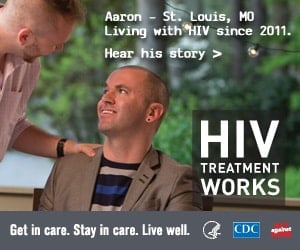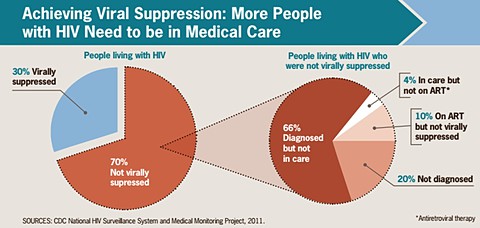
Cedric has been living with HIV since 2013. In the video below, he and others living with HIV talk about how their lives have dramatically improved since seeking treatment and getting proper care.
More than 1.2 million Americans are living with HIV. Approximately 168,000 of those people have never been diagnosed. Additionally, more than 50% of those infected with HIV are not being treated.
 The Centers for Disease Control and Prevention (CDC) knows that the key way to help people living with HIV to achieve longer, healthier lives is by getting people the proper medical care they need in order to lower the levels of HIV in the body. Not only does viral suppression facilitate life spans that are near normal, but it inhibits transmission of HIV to others.
The Centers for Disease Control and Prevention (CDC) knows that the key way to help people living with HIV to achieve longer, healthier lives is by getting people the proper medical care they need in order to lower the levels of HIV in the body. Not only does viral suppression facilitate life spans that are near normal, but it inhibits transmission of HIV to others.
And only 30% of those living with HIV have achieved viral suppression. That number could be raised to 76% by getting people the proper care they need. People tend to avoid seeking care because of poor access, cost of pharmaceuticals, a lack of knowledge about treatments, and stigma attached to HIV, but the CDC's study shows how vitally important it is to get people tested for HIV, and into care as soon as possible once diagnosed.
In fact, a 20-year-old diagnosed with HIV who gets the proper medical treatment adds an average of nearly 40 years to his or her life.
Treatment works, and that's the message of the CDC's campaign which is informed by the input of more than 100 people living with HIV. In the video we featured last week, several of them talk about when they discovered they needed to seek care. In the video below, they talk about living well and the difference having good care has made in their lives.
"Don't wait [to seek care]," says Cedric, who has been living with HIV since 2013. "It's not something where you can just sit around and say, 'oh, I'll go tomorrow' or 'I'll wait until next week, I don't feel well right now.'… [Knowing that] it's under control, that I have it by the neck, that's important to me."

To read more about how HIV treatment works, visit the CDC's website to find out how to get in care, stay in care, live well, and find the resources and social services providers that will help you achieve viral suppression and live a longer, healthier life.
SPONSORED POST




